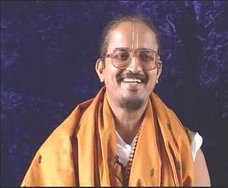Nama Article 30th June 2015
Swami Papa Ramdas
Devotee: What is the ideal Grihastha-life that will lead to the final goal?
Papa: Before the advent of Sri Krishna there were in vogue four stages for the realisation of God: Brahmacharya, Garhasthya, Vanaprastha and, last of all, Sannyasa. Only after passing through the first three stages was a man deemed fit to attain liberation by renouncing the worldly life altogether. Of course, even during the Vanaprastha stage he goes to the forest, but he is not completely detached from the worldly life. Ultimately, he breaks all his ties binding him to worldly relations and possessions, and then reaches the final state of absolute renunciation called Sanyasa.
What about those who cannot renounce and who are made to live in the world till the last? For them Lord Krishna has established what is called the Bhagavata Dharma. This is a path of perfect dedication and surrender to the will and power of the Divine. To attain to this state, He has pointed out the path of Bhakti as the means. The ideal Grihastha-life, consists in living according to this Bhagavata Dharma of selfdedication, of complete surrender to the will of God.
The life of the great Maharashtrian saint, Eknath Maharaj, was the ideal one of a householder according to the Bhagavata Dharma. He was a householder to the very last and had not to renounce the worldly life. He says in one of his teachings that the life of a Grihastha must be entirely dedicated to God. Dedication does not mean renunciation. As regards the so-called responsibility of looking after his family, he must only feel that he is doing everything as an agent of God.
As Sri Ramakrishna has said, 'Give the power of attorney to God and live in the world feeling that you are merely a servant obeying His commands, that everything belongs to Him.' Serve people in the house in His name and then it is that we live the true Grihastha's life. The functions or duties of a Grihastha are described in the Upanishads as follows:
'First of all you must treat your parents as the very forms of God. Whenever Athithis, guests, come to you, you must treat them with all love and hospitality, looking upon them as God Himself. You must consider your Guru as God and worship Him.'
So Grihasthas must serve Sadhus and saints with all reverence. Whatever service they do, must be done in all humility, love and devotion. Living the Grihastha-life with this attitude, will lead to continuous remembrance of God and the ultimate realisation of Him.
Chant the Mahamantra Nama kirtan :
Hare Rama Hare Rama Rama Rama Hare Hare
Hare Krishna Hare Krishna Krishna Krishna Hare Hare
--------------------------------------------------------
--------------------------------------------------------
For more Namakirtan articles please visit http://guruandnamakirtan.blogspot.com/

No comments:
Post a Comment